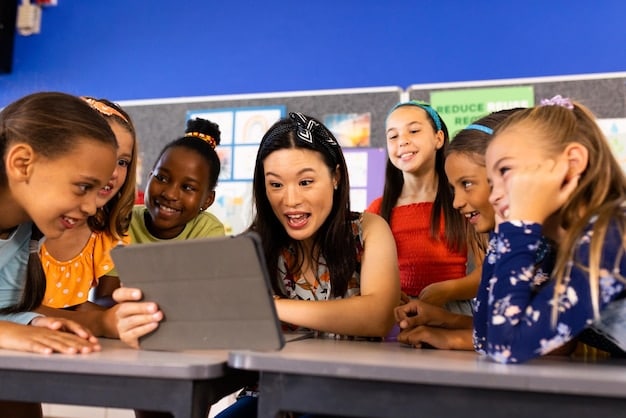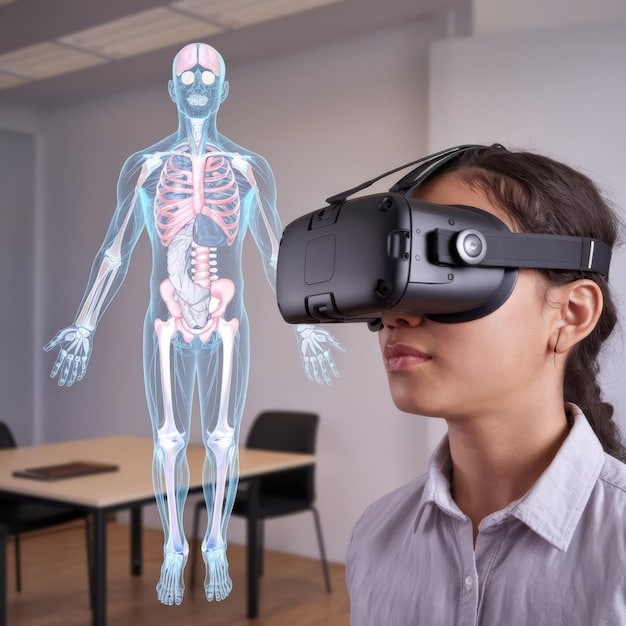How AI and EdTech Are Reshaping US Education: A Deep Dive

Technology is fundamentally transforming the education system in the US by introducing personalized learning, enhancing classroom engagement through interactive tools, and expanding access to educational resources, thereby preparing students for a rapidly evolving digital world.
The landscape of education is in constant flux, but few forces have reshaped it as profoundly as technological innovation. Understanding how is technology transforming the education system in the US is key to grasping the future of learning, from K-12 classrooms to higher education institutions and beyond. This article delves into the profound shifts brought about by digital tools, platforms, and mindsets, examining both the opportunities and the inherent challenges.
The Evolution of the Classroom: From Chalkboards to Cloud Platforms
For centuries, the classroom remained a relatively static environment. The primary tools were chalkboards, textbooks, and the wisdom imparted by a teacher. However, the advent of digital technology has ushered in an era of unprecedented transformation, fundamentally altering how knowledge is disseminated, absorbed, and applied within the US education system.
Today, classrooms are increasingly dynamic spaces where digital tools often complement, or even replace, traditional methods. This shift isn’t merely about substituting physical objects with digital ones; it’s about re-imagining pedagogical approaches and extending the reach of education beyond traditional boundaries. The integration of technology aims to create more engaging, interactive, and inclusive learning experiences for students across all levels.
Interactive Learning Environments
The introduction of interactive whiteboards, touchscreens, and virtual reality (VR) headsets has moved classrooms from passive listening to active participation. These tools allow for dynamic visual presentations, collaborative problem-solving, and immersive experiences that cater to diverse learning styles.
- Virtual field trips enable students to explore distant historical sites or scientific phenomena from their desks.
- Interactive simulations provide hands-on experience for complex scientific or engineering concepts without risk.
- Gamified learning platforms increase student engagement by turning lessons into challenges with rewards.
Personalized Learning Pathways
Perhaps one of the most significant impacts of technology is its ability to facilitate personalized learning. AI-driven platforms can adapt to an individual student’s pace, preferences, and prior knowledge, offering content and exercises tailored to their specific needs. This contrasts sharply with the “one-size-fits-all” model of traditional education.
Diagnostic tools can identify specific areas where a student struggles or excels, allowing educators to intervene effectively. Algorithmic recommendations guide students through curriculum paths that optimize their learning journey, presenting material in a sequence and format most conducive to their understanding.
The data collected by these systems also provides teachers with valuable insights, enabling them to make more informed decisions about instruction and support. This continuous feedback loop helps refine teaching strategies and ensures that no student is left behind or unchallenged.
In essence, technology is breaking down the rigid structures of the past, creating more fluid and responsive educational environments that better serve the diverse needs of learners in the US, laying the groundwork for a future where education is truly tailored to the individual.
Expanding Access and Bridging Gaps Through Digital Tools
Technology’s role in education extends far beyond the classroom walls, serving as a powerful equalizer by expanding access to learning resources and opportunities, particularly in remote areas or for underserved populations in the US. The digital realm has become a vast library and a virtual campus, offering possibilities that were once unimaginable.
The rise of online learning platforms and open educational resources (OER) has democratized access to high-quality content. Students who might not have had the chance to attend traditional brick-and-mortar institutions can now pursue degrees and certifications from anywhere with an internet connection, fostering a more inclusive educational ecosystem.
Remote Learning and Online Platforms
The rapid shift to remote learning during recent global events highlighted the critical role of technology in maintaining educational continuity. Platforms like Zoom, Microsoft Teams, and Google Classroom became indispensable, allowing synchronous and asynchronous learning to continue uninterrupted. These tools facilitated not only live instruction but also collaborative work, assignment submission, and feedback loops.
- Online degree programs provide flexible pathways for adult learners and working professionals to further their education.
- Massive Open Online Courses (MOOCs) offer free or low-cost access to university-level content from top institutions worldwide.
- Virtual tutoring and mentoring platforms connect students with experts, overcoming geographical barriers.
Digital Equity Challenges
While technology offers immense potential for access, it also exposes and sometimes exacerbates existing inequalities. The “digital divide” remains a significant challenge in the US, where disparities in internet access and device availability can create new barriers to learning. Addressing this requires concerted efforts from policymakers, educators, and communities.
Initiatives to provide subsidized internet access, distribute computing devices to students in need, and establish community tech centers are crucial in ensuring that the benefits of educational technology are broadly shared. Without equitable access, the promise of digital transformation in education risks remaining unfulfilled for a considerable portion of the student population.
Moreover, digital literacy is as important as access. Training for both students and educators is essential to ensure that technology is used effectively and responsibly. The goal is not just to provide tools but to empower users to leverage them for meaningful learning outcomes, fostering a more equitable and connected educational future.
Enhancing Teacher Capabilities and Pedagogical Innovation
The transformative power of technology in education is not limited to student learning; it also profoundly impacts educators, empowering them with new tools and insights that enhance their instructional capabilities and foster pedagogical innovation. In the US, teachers are increasingly relying on technology to streamline administrative tasks, differentiate instruction, and collaborate more effectively.
By automating mundane tasks, technology frees up valuable time for teachers, allowing them to focus more on direct instruction, personalized student support, and professional development. This shift encourages educators to evolve from being mere disseminators of information to facilitators of learning, guiding students through complex concepts and fostering critical thinking skills.
Data-Driven Instruction
Educational technology provides teachers with unprecedented access to data on student performance. Learning management systems (LMS) and assessment tools can track student progress, identify learning patterns, and pinpoint areas where individual students or entire classes might be struggling. This data-driven approach allows teachers to make informed decisions about their teaching strategies.
For instance, a teacher can analyze student responses to an online quiz to immediately identify common misconceptions and address them in the next lesson. This continuous feedback loop enables agile adjustments to curriculum delivery, ensuring that instruction is always tailored to the evolving needs of the learners.
Predictive analytics, a growing field in educational technology, can even alert teachers to students who might be at risk of falling behind, allowing for early intervention and support. This proactive approach can significantly improve student outcomes and reduce the likelihood of academic failure.
Professional Development and Collaboration
Technology also opens up new avenues for teacher professional development (PD). Online courses, webinars, and virtual communities of practice allow educators to continuously update their skills, learn new pedagogical approaches, and share best practices with peers across the country and even globally. This ongoing learning is crucial for staying abreast of the rapid changes in both technology and educational theory.

Collaborative platforms enable teachers to co-create lesson plans, share resources, and provide mutual support. This professional networking strengthens the educational community, fostering a culture of continuous improvement and innovation. For instance, teachers from different schools can collaborate on interdisciplinary projects, enriching the learning experience for their students.
The integration of technology thus empowers teachers not only to teach more effectively but also to grow professionally, creating a more dynamic and responsive educational workforce capable of navigating the complexities of the 21st-century classroom.
Challenges and Ethical Considerations in EdTech Adoption
While the promises of educational technology are vast, its widespread adoption in US schools is not without significant challenges and ethical considerations. Navigating these complexities is crucial for ensuring that technology serves as a beneficial tool rather than a source of new problems or inequalities. We must critically examine issues ranging from data privacy to equitable implementation.
One of the foremost concerns revolves around the digital divide, a persistent gap in access to devices and high-speed internet that disproportionately affects low-income families and rural communities. Without equitable access, technology can exacerbate existing educational disparities, rather than alleviate them.
Data Privacy and Security
The increasing use of digital platforms in education means that vast amounts of student data—from academic performance to behavioral patterns—are being collected. This raises serious concerns about data privacy and security. Schools and EdTech providers have a responsibility to protect this sensitive information from breaches and misuse.
- Strict adherence to regulations like COPPA (Children’s Online Privacy Protection Act) is essential.
- Educating parents, students, and educators about data privacy best practices is crucial for fostering informed vigilance.
- Transparent data collection and usage policies are necessary to build trust within the educational community.
Furthermore, the ethical implications of using student data for purposes beyond direct instruction, such as targeted advertising or predictive analytics that could lead to labeling or bias, must be carefully considered by policymakers and institutions alike. Striking a balance between leveraging data for personalized learning and protecting individual rights is a delicate act.
Teacher Training and Professional Development
The successful integration of technology in the classroom heavily depends on teachers’ readiness and ability to use these tools effectively. Many educators, particularly those from older generations, may lack the necessary digital literacy or pedagogical training to fully leverage EdTech. Insufficient professional development can lead to underutilized resources or ineffective teaching practices.
Ongoing, high-quality training is essential, focusing not just on the technical aspects of using software or devices but also on how to integrate technology meaningfully into the curriculum to enhance learning outcomes. This includes understanding when and how to use technology appropriately, and when traditional methods might be more effective.
Investment in robust professional development programs is critical to empower teachers and ensure that EdTech investments translate into tangible improvements in the learning experience for all students.
Addressing these challenges requires a multifaceted approach involving policy, investment, and continuous dialogue among all stakeholders in the education ecosystem.
The Impact of Artificial Intelligence and Machine Learning
The transformative potential of technology in education is rapidly evolving with the integration of Artificial Intelligence (AI) and Machine Learning (ML). These advanced technologies are poised to revolutionize various facets of the US education system, moving beyond mere digitization to intelligent automation and highly personalized interaction. AI and ML are enabling adaptive learning experiences, automating administrative tasks, and offering unprecedented insights into student performance.
The application of AI aims to create smarter, more responsive educational environments. From intelligent tutoring systems that mimic human instruction to sophisticated analytics that identify learning challenges, AI is set to redefine the boundaries of what is possible in teaching and learning.
Intelligent Tutoring Systems (ITS)
AI-powered Intelligent Tutoring Systems are perhaps one of the most promising applications of this technology. These systems can provide personalized, real-time feedback to students, adapting the content and difficulty level based on the student’s performance and learning style. Unlike traditional software, ITS can understand nuances in responses and offer tailored explanations.
- AI tutors can provide immediate feedback on essays, highlighting grammatical errors or logical inconsistencies.
- Adaptive practice exercises adjust difficulty dynamically, ensuring students are always challenged appropriately.
- Virtual assistants can answer student queries 24/7, reducing dependency on human instructors for basic information.
This level of personalized instruction, previously only possible through high-cost one-on-one tutoring, now becomes scalable and accessible through AI. This helps address the diverse learning needs within a large classroom setting.
Automated Assessments and Analytics
AI is also streamlining the assessment process. Automated grading systems can efficiently evaluate various types of assignments, including essays and coding projects, providing rubric-based scoring. This significantly reduces the time teachers spend on grading, allowing them more time for direct instruction and student interaction.
Beyond grading, AI and ML provide powerful analytical capabilities. They can process vast amounts of student data to identify trends, predict at-risk students, and even recommend interventions. This data-driven insight helps educators fine-tune their teaching strategies for maximum impact.
However, it is crucial to ensure that AI-driven assessments are fair, unbiased, and transparent, avoiding the perpetuation of existing inequalities. Ethical considerations regarding algorithmic bias and data interpretation are paramount as these technologies become more integrated into the educational fabric.

The transformative power of AI and ML in education is immense, offering the potential to create truly personalized, efficient, and data-informed learning experiences, pushing the boundaries of traditional pedagogy.
The Future Landscape: Preparing Students for a Digital World
As technology continues its relentless pace of innovation, the US education system faces the critical task of preparing students not just for the present, but for a future increasingly defined by digital fluency and technological integration. The rapid evolution of fields like artificial intelligence, robotics, and biotechnology necessitates a fundamental shift in pedagogical priorities, moving beyond rote memorization to fostering skills essential for the 21st century.
The traditional model of education, which often prioritized content delivery, is giving way to an emphasis on competencies such as critical thinking, problem-solving, creativity, and collaboration. These skills are inherently enhanced by technology, which provides the tools and platforms for their development and application.
Cultivating 21st-Century Skills
The jobs of tomorrow will demand a workforce that is adaptable, innovative, and technologically adept. Education must therefore focus on cultivating skills that go beyond vocational training to encompass a broader range of cognitive and socio-emotional capabilities. Technology plays a pivotal role in this cultivation.
- Digital Literacy: Understanding how to navigate, evaluate, and create information in digital environments.
- Computational Thinking: Approaching problems like a computer scientist, breaking them down into manageable steps.
- Media Literacy: Critically analyzing and producing media in various forms, discerning credible sources from misinformation.
- Collaboration: Working effectively in virtual teams using online collaboration tools.
These skills are not merely theoretical; they are practiced through project-based learning, online collaborative assignments, and the use of simulation tools that mirror real-world challenges. By integrating these practices, education systems can ensure students are not just consumers of technology, but active creators and innovators.
Lifelong Learning and Adaptability
The pace of technological change means that education can no longer be seen as a finite period in one’s life. Instead, it must instil a mindset of lifelong learning and adaptability. Technology facilitates this by providing continuous access to learning resources and opportunities for upskilling and reskilling throughout an individual’s career.
Online courses, professional certifications, and micro-credentials allow individuals to acquire new knowledge and skills as needed, responding to the evolving demands of the job market. This flexibility is crucial in an era where job roles and industries can emerge and disappear rapidly.
Ultimately, the goal is to equip students with the ability to learn independently, critically evaluate information, and leverage technology as a tool for innovation and personal growth, ensuring they are well-prepared to thrive in an ever-changing digital world.
Addressing Digital Inclusivity and Ethical Frameworks
As technology integrates more deeply into the fabric of the US education system, ensuring digital inclusivity and establishing robust ethical frameworks become paramount. The mere presence of technology does not guarantee equitable outcomes; purposeful design and thoughtful policy are required to prevent widening existing divides and to foster responsible usage.
Digital inclusivity extends beyond providing devices and internet access. It encompasses ensuring that all students, regardless of socioeconomic status, disability, or geographic location, have the opportunity to engage meaningfully with educational technology and develop the necessary digital literacies.
Promoting Digital Accessibility
Accessibility for students with disabilities must be a core principle in the design and implementation of educational technology. This involves ensuring that platforms and content are compatible with assistive technologies, offering alternative formats, and designing interfaces that minimize barriers to learning for all users.
- Providing screen readers for visually impaired students and closed captioning for hearing-impaired students are crucial.
- Designing content with clear, concise language and adaptable visual elements benefits a wide range of learners.
- Exploring voice command features and alternative input methods caters to students with motor disabilities.
Beyond technical features, training educators on how to utilize accessible technologies effectively is essential to maximize their impact. Collaboration between EdTech developers, educators, and accessibility experts is vital to create truly inclusive digital learning environments.
Developing Ethical Guidelines for AI in Education
The increasing deployment of Artificial Intelligence in education necessitates the development of clear ethical guidelines. Concerns regarding algorithmic bias, data privacy, and the potential for AI to influence learning outcomes in a non-transparent manner must be proactively addressed.
Ethical frameworks should ensure that AI systems are fair, accountable, and transparent. This means understanding how AI algorithms make decisions, preventing biases that could disadvantage certain student populations, and establishing clear protocols for data governance and student privacy.
Discussion and debate around these ethical considerations are crucial for building trust in AI-powered educational tools among students, parents, and educators. Ultimately, the goal is to harness the power of technology responsibly, ensuring it serves to enhance, not diminish, human potential and equity in education.
| Key Aspect | Brief Description |
|---|---|
| 💻 Personalized Learning | AI-driven platforms adapt content to individual student pace and style for optimal engagement. |
| 🌐 Expanded Access | Online platforms and OER bridge geographical gaps and offer flexible learning pathways. |
| 📊 Data-Driven Instruction | Analytics help teachers tailor strategies and identify struggling students for early intervention. |
| 🛡️ Ethical Challenges | Concerns about data privacy, digital equity, and AI bias require robust frameworks. |
Frequently Asked Questions About Technology in US Education
Technology personalizes learning by leveraging AI and adaptive algorithms to gauge individual student progress and learning styles. It delivers customized content, exercises, and feedback tailored to each student’s needs, pace, and interests. This approach allows students to master concepts before moving on, fostering deeper understanding and engagement regardless of their initial proficiency level.
Technology significantly benefits teachers by automating administrative tasks like grading and record-keeping, freeing up time for instruction. It provides data-driven insights into student performance, enabling more targeted teaching strategies. Furthermore, technology facilitates access to professional development resources and allows for greater collaboration among educators, enhancing pedagogical innovation and efficiency in the classroom.
Technology addresses educational equity by expanding access to high-quality resources and learning opportunities, especially for students in remote or underserved areas. Online platforms, virtual classrooms, and open educational resources democratize learning, making advanced courses and specialized instruction available to a broader audience. While the digital divide remains a challenge, concerted efforts aim to bridge these gaps and ensure inclusive access.
Ethical concerns in educational technology primarily revolve around student data privacy and security, as vast amounts of personal information are collected and stored. There are also important considerations regarding algorithmic bias in AI-powered tools, which could perpetuate or exacerbate existing inequalities. Ensuring equitable access to technology and preventing the digital divide from widening are also critical ethical challenges.
AI is profoundly shaping the future of education in the US by powering intelligent tutoring systems that offer personalized, adaptive learning experiences. It also automates assessments and provides predictive analytics that help identify at-risk students sooner. This leads to more efficient and effective teaching interventions, preparing students with critical thinking and problem-solving skills necessary for an increasingly digital and AI-driven world.
Conclusion
The transformation of the US education system by technology is undeniable and continues at a rapid pace. From personalized learning pathways and expanded access to knowledge, to enhanced teacher capabilities and the revolutionary impact of AI, digital tools are fundamentally reshaping how students learn and educators teach. While challenges such as digital equity, data privacy, and the need for continuous professional development remain, the potential for technology to create more engaging, inclusive, and effective learning environments is immense. By thoughtfully integrating these innovations, the US education system can better prepare its students for the complexities and opportunities of a rapidly evolving global society.





